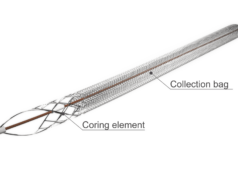
During a presentation at the 2024 European Vascular Course (EVC; March 3–5) in Maastricht, The Netherlands, Anna Pouncey, a clinical research fellow for vascular surgery at Imperial College London in London, England, presented findings from a study on the cost-effectiveness of early thrombus removal for acute iliofemoral deep vein thrombosis (DVT).
The objective of the study was to look at early clot removal using endovascular intervention, which aims to reduce post-thrombotic syndrome (PTS) following iliofemoral DVT. The presenter noted that this technique has the possibility to reduce long-term morbidity, though it incurs a higher cost initially. The study examined the cost-effectiveness of pharmacochemical thrombectomy (PMT) and catheter-directed thrombolysis (CDT) in comparison with oral anticoagulation for acute iliofemoral DVT in the United Kingdom.
Pouncey opened her presentation by explaining what cost-effectiveness meant in the study. “Our healthcare resources are finite,” she said. “So, if you spend a load of money on a treatment that doesn’t work, you are essentially going to harm patients and harm the healthcare system…Instead, you want to cause a health-gain, and you want this to be at an acceptable cost.”
The effect of treatment on patients was measured using quality-adjusted life years (QALYs), which are a measure of how valuable the patient’s quality of life is adjusted for how long they’re living. “We can then use this to calculate something called an ICER, which is an incremental cost effectiveness ratio,” Pouncey told the audience. DVT “is a really significant health-economic burden. So, 50%, roughly, of patients with an iliofemoral DVT will go on to develop [PTS]. This is a chronic, debilitating, and really expensive condition.”
Pouncey then went on to describe how she and her team went about their study.
“The first step when you perform a cost-effectiveness analysis, is you need to know what you’re looking at,” she said. “You need to know the patient population that you’re looking at.”
Pouncey and her team used a front-end decision tree to model possible patient outcomes in the acute setting. She explained that, “these are things like death, pulmonary embolism and bleeding from the treatment. Then once a patient, if they survived, got through to the chronic health state, we used something called a Markov model to model transitions between PTS states over time.”
The study defined cost based on the United Kingdom’s National Health Service national tariff workbook, and used micro-costing for the procedures based on clinical practice at Guy’s and St Thomas’ Hospital, London.
“We added up the early cost of intervention, and if you look at oral coagulation, it’s considerably cheaper than CDT and PMT. That is because of the cost of stenting, equipment, and increased hospital stay,” Pouncey stated.
However, after performing a base case analysis, the results were interesting.
“What we actually found is that both CDT and PMT were dominant over oral coagulation. What that means, is that they were both more effective and, over the lifetime, less costly,” Pouncey explained.
“In conclusion, CDT and PMT may be cost effective over [oral anticoagulation],” Pouncey told the audience. “This is because of a reduction in the long-term costs of moderate and severe PTS, will offset the early treatment costs. However, there is still significant uncertainty, and we need to continually update our analyses, taking into advancement in procedural techniques and change to clinical practice.”









